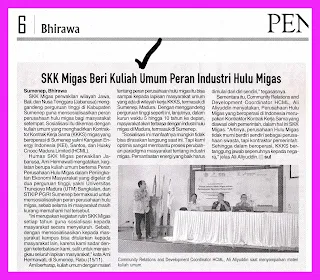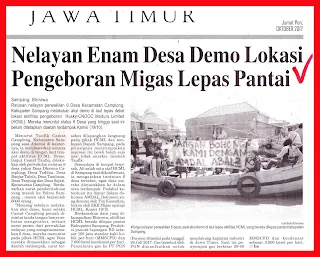Estimates of the need for gas imports to meet national demand continue to retreat, from initially starting 2019 then to 2020, as the realization of gas consumption is not as high as expected. To boost domestic gas consumption, the government needs to provide incentives for industries that are big consumers of gas.
Group Head Marketing PT Perusahaan Gas Negara (PGN) Adi Munandir said Indonesia's gas balance has shown a supply deficit since 2016. However, until now, gas imports have not been required. This is because the gas balance is prepared based on the contract of sale and purchase of gas, not the realization of consumption.
"The deficit assumption is also influenced by the realization of the projection. Contract-based gas balance, while the realization is under it because it is influenced by the dynamics of the economy and also the development of demand, "he said.
The administration of President Joko Widodo (Jokowi) is indeed boosting infrastructure development such as the 35,000 Megawatt Program (MW), the development of industrial zones and special economic zones. This makes the natural gas market in Indonesia attractive to investors. However, this projected picture of gas demand is called Adi, will not grow if no effort is made.
"But if we treat the number as a target, then we must do something to make it happen. So the gas balance becomes a policy tool that drives policy on infrastructure development that must be built at a certain time and gas production to be done. The gas balance becomes our driver and demand driven management, "said Adi.
However, increasing domestic gas consumption is not as easy as estimated. This can be seen from the initiative of the development of Special Economic Zone (KEK) Sei Mangkei, Kuala Tanjung or Constraints that have not been realized. He said the development of the natural gas market requires integrated planning and integrated action.
"The synergy between the key stakeholders of the demand side such as the Ministry of Industry, from the Ministry of Finance to provide stimulus and incentives, and from the Ministry of Energy and Mineral Resources, together to grow the demand," said Adi.
According to him, many parties, including from the government, focus on the gas supply strategy and supply of natural gas, including rely on imports. Whereas what should be done how to increase the consumption of natural gas in the country. This is because the strategy of how to boost domestic gas consumption is as important as ensuring its supply.
"For that, looking at the current gas balance should be done with caution. The government sees that gas imports are not yet needed because of the availability of sufficient domestic gas supply. So the tough task is to build the domestic market so that all domestic gas production can be utilized domestically into the energy that drives the Indonesian economy, "said Adi.
Integrated
PGN itself, continued Adi, will become a company with integrated solutions that can handle the problem of gas supply. Now PGN not only serves gas supply through pipeline. PGN also has subsidiaries engaged in the business of liquefied natural gas (LNG) as well as its regasification. However, PGN is not just building infrastructure, but also building the gas market.
"We have to cultivate demand, take initial risks, and campaign for a growing gas market," Adi said.
For the development of its own infrastructure, PGN continues to add the infrastructure it manages. In the meantime, Director of PGN Infrastructure and Technology Dilo Seno Widagdo said that his side has budgeted around US $ 200 million for the development of gas infrastructure.
The addition of infrastructure in the form of gas transmission and distribution pipeline is expected to increase the utilization of gas by consumers. PGN this year worked on several projects at once. First, the construction of a 67-km-long Duri-Dumai transmission pipeline in cooperation with PT Pertamina Gas, which is a government assignment project since 2016. In Duri, PGN also builds a 60-km distribution pipeline.
Second, West Natuna Transportation System (WNTS) transmission pipeline construction project which is a government assignment. PGN builds a 5 km pipeline with a capacity of 120 million cubic feet per day targeted for completion this year.
Third, the development of East Java network in the village of Semare along 2.2 km and diameter 10-16 inches. Meanwhile, gas supply is obtained from Husky-CNOOC Madura Limited (HCML) with volume of 60 million cubic feet per day. Finally, the assignment of the construction of a household gas network of 26,000 house connections (SR) that will connect the pipeline to the community in Mojokerto, East Java; Musi Banyuasin, South Sumatra; Jakarta and Bandar Lampung.
The total of PGN's existing and managed gas infrastructure currently reaches more than 7,270 km. This amount is equivalent to 80% of the downstream gas pipeline throughout Indonesia. Currently PGN has supplied over 1,658 large industries and power plants, more than 1,930 commercial customers, and 204,000 household customers spread across 19 districts / cities in 12 provinces throughout Indonesia.
IN INDONESIA
Genjot Konsumsi Gas Domestik, Pemerintah Harus Beri Insentif ke Industri
Perkiraan perlunya impor gas untuk memenuhi kebutuhan nasional terus mundur, dari awalnya mulai 2019 kemudian menjadi 2020, karena realisasi konsumsi gas tidak setinggi perkiraan. Untuk menggenjot konsumsi gas domestik, pemerintah perlu memberikan insentif bagi industri yang merupakan konsumen besar gas.
Group Head Marketing PT Perusahaan Gas Negara (PGN) Adi Munandir mengatakan, neraca gas bumi Indonesia sudah menunjukkan defisit pasokan sejak 2016. Namun, hingga saat inipun, impor gas belum diperlukan. Hal ini karena neraca gas tersebut disusun berdasarkan kontrak jual beli gas, bukan realisasi konsumsi.
“Asumsi defisit juga dipengaruhi oleh realisasi proyeksi. Neraca gas berbasis kontrak, sedangkan realisasinya berada di bawahnya karena dipengaruhi dinamika perekonomian dan juga pembangunan demand,” kata dia
Pemerintahan Presiden Joko Widodo (Jokowi) memang sedang menggenjot pembangunan infrastrutkur seperti Program 35.000 Megawatt (MW), pengembangan kawasan industri, dan kawasan ekonomi khusus. Hal ini membuat pasar gas bumi di Indonesia menjadi menarik bagi investor. Namun, gambaran proyeksi permintaan gas ini disebut Adi, tidak akan tumbuh jika tidak ada upaya apapun.
“Namun kalau kita perlakukan angka tersebut sebagai target, maka kita harus melakukan sesuatu untuk merealisasikannya. Sehingga neraca gas menjadi alat kebijakan yg men-drive kebijakan mengenai pengembangan infrastruktur yang harus dibangun di waktu tertentu dan produksi gas yang harus dilakukan. Neraca gas menjadi driver dan pengelolaan kita demand driven,” kata Adi.
Hanya saja, meningkatkan konsumsi gas bumi dalam negeri tidak semudah yang diperkirakan. Hal ini terlihat dari inisiatif pembangunan Kawasan Ekonomi Khusus (KEK) Sei Mangkei, Kuala Tanjung atau Kendala yang belum juga terealisasi. Dikatakannya, pengembangan pasar gas bumi membutuhkan integrated planning dan integrated action.
“Sinergi antara key stakeholders dari sisi demand seperti Kementerian Perindustrian, dari sisi Kementerian Keuangan untuk memberikan stimulus dan insentif, serta dari Kementerian ESDM, bersama sama menumbuhkan demand tersebut,” kata Adi.
Menurutnya, banyak pihak termasuk dari pemerintah, fokus terhadap strategi pasokan gas bumi dan pengadaan pasokan gas bumi, termasuk mengandalkan impor. Padahal harusnya yang dilakukan bagaimana meningkatkan konsumsi gas bumi dalam negeri. Hal ini karena strategi bagaimana menggenjot konsumsi gas domestik sama pentingnya dengan upaya menjamin pasokannya.
“Untuk itu, melihat neraca gas saat ini harus dilakukan dengan kehati-hatian. Pemerintah melihat bahwa impor gas belum diperlukan karena ketersediaan pasokan gas domestik yang masih cukup. Maka tugas beratnya adalah membangun pasar domestik sehingga seluruh gas produksi dalam negeri bisa dimanfaatkan di dalam negeri menjadi energi yang menggerakan perekonomian Indonesia,” tutur Adi.
Terintegrasi
PGN sendiri, lanjut Adi, bakal menjadi perusahaan dengan solusi terintegrasi yang dapat menangani masalah pasokan gas. Kini PGN tidak hanya melayani pasokan gas melalui pipa. PGN juga telah memiliki anak usaha yang bergerak di bisnis gas alam cair (liquefied natural gas/ LNG) sekaligus regasifikasinya. Namun, PGN tidak sekadar membangun infrastruktur, tetapi juga ikut membangun pasar gas.
“Kita harus memupuk demand, mengambil resiko awal, dan melakukan kampanye agar pasar gas berkembang,” kata Adi.
Untuk pengembangan infrastruktur sendiri, PGN terus menambahkan inrastruktur yang dikelolanya. SebeIumnya, Direktur Infrastruktur dan Teknologi PGN Dilo Seno Widagdo mengatakan, pihaknya menganggarkan dana sekitar USS 200 juta untuk pembangunan infrastruktur gas.
Penambahan infrastruktur berupa pipa gas transmisi dan distribusi ini diharapkan mampu menambah pemanfaatan gas oleh konsumen. PGN tahun ini menggarap beberapa proyek sekaligus. Pertama, pembangunan pipa transmisi Duri-Dumai sepanjang 67 kilometer (km) bekerja sama dengan PT Pertamina Gas yang merupakan proyek penugasan pemerintah sejak 2016. Di Duri, PGN juga membangun pipa distribusi sepanjang 60 km.
Kedua, proyek pembangunan pipa transmisi West Natuna Transportation System (WNTS)-Pemping yang merupakan penugasan pemerintah. PGN membangun pipa pipa penghubung sepanjang 5 km dengan kapasitas 120 juta kaki kubik per hari yang ditargetkan selesai di tahun ini.
Ketiga, pengembangan jaringan Jawa Timur yakni di Desa Semare sepanjang 2,2 km dan berdiameter 10-16 inchi. Adapun, pasokan gas diperoleh dari Husky-CNOOC Madura Limited (HCML) dengan volume 60 juta kaki kubik per hari. Terakhir, penugasan pembangunan jaringan gas rumah tangga sebanyak 26.000 sambungan rumah (SR) yang akan menghubungkan pipa ke masyarakat di Mojokerto, Jawa Timur; Musi Banyuasin, Sumatera Selatan; Jakarta dan Bandar Lampung.
Total infrastruktur gas bumi yang dibandung dan dikelola PGN saat ini mencapai lebih dari 7.270 km. jumlah ini setara 80% pipa gas bumi hilir seluruh Indonesia. Saat ini PGN telah memasok lebih dari 1.658 industri besar dan pembangkit listrik, lebih dari 1.930 pelanggan komersial, dan 204.000 pelanggan rumah tangga yang tersebar di 19 kabupaten/kota di 12 provinsi di seluruh Indonesia.
Investor Daily, Page-9, Monday, July 24, 2017











